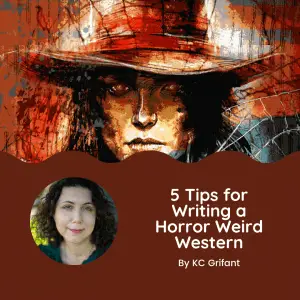5 Tips for Writing a Horror Weird Western
5 Tips for Writing a Horror Weird Western
By KC Grifant
 There’s no doubt about it: there has been a recent surge in historical horror fiction, especially in the “Weird West” category. Maybe you’ve read a recent anthology featuring horror tales that take place in the Old West or come across “splatter westerns.” Whatever the case, the Weird West genre is making a comeback. Read on for more about this fascinating genre as well as tips for writing your own weird western.
There’s no doubt about it: there has been a recent surge in historical horror fiction, especially in the “Weird West” category. Maybe you’ve read a recent anthology featuring horror tales that take place in the Old West or come across “splatter westerns.” Whatever the case, the Weird West genre is making a comeback. Read on for more about this fascinating genre as well as tips for writing your own weird western.
What is the Weird West?
The term “Weird West” emerged around the 1970s with the debut of DC’s Weird Western Tales. Since then, Weird West stories have appeared in popular culture mediums, like Deadlands, The Wild Wild West, Preacher, Jonah Hex and many more.
Very generally, the Weird West fuses elements of the American West—including folklore, settings and aesthetics—with genres like horror, science fiction and/or fantasy. Horror is one of the most common fusions, featuring tales of haunted lands, monsters and brutal encounters that reflect some of the darker violence of the times. The subgenre sometimes also crosses over to—or is often used synonymously with—gothic westerns, historic fantasies, alternate histories, and splatter westerns (more on that below).
To some, the Weird West can also encompass space westerns, or stories set in regions outside of the American frontier around the same time period (roughly late 1800s). Typically, these stories feature lone figures facing insurmountable obstacles in vast, unforgiving landscapes.
Why write a Weird West story?
Picture this: a gunslinger in a hat and duster bursts into a saloon, sending poker players and prostitutes scrambling for cover before the inevitable showdown. This scene could be from a thousand different movies or books. The mythical cowboy hero archetype is entrenched in American history for better or worse, but the Weird West genre offers an avenue for a fresh take on the iconic—and sometimes overused—stereotypes of the Old West.
The Weird West can also be a vehicle to explore some of the untold stories of those times and to reimagine the entrenched views of the Old West. Some authors write Weird West stories to bring to light real issues people have faced historically. For example, many groups (especially Chinese and African Americans) dealt with rampant and brutal racism, while Indigenous groups faced unthinkable violence as they contended with the loss of their lands and cultures, along with horrific massacres. Tales about this time period, weird or otherwise, can find meaningful ways to tell important new stories (provided you do so with common sense and sensitivity).
5 Tips for Writing Your Own Weird West story
If you’re interested in trying out a story in this genre, here are 5 tips I’ve found helpful. As you read through, keep in mind the basic recipe: combine your favorite aesthetics from a traditional Western with speculative elements. Dinosaurs, vampires, cursed objects—nothing is off-limits in the Weird West.
Tip 1: Follow parameters in the genre
Of course, there are exceptions, but generally these parameters should be met to classify a story as a Weird West: the time period should be roughly between 1810-1912; the story should take place in a world resembling or parallel to the American Old West; and there must be some speculative aspect to the story (supernatural or otherworldly).
Tip 2: Use Old West dialect meaningfully
There’s a lot of websites and resources offering “cowboy sayings” and “western slang” that are incredibly useful. Analogies and slang of a time period can add essential flavor and style to a Weird West story. However, dialect can be overdone, making your story distracting, hard to read, or even corny. I generally recommend that writers who are new to the genre use slang and dialect sparingly—think of it as a strong spice and sprinkle in careful amounts.
Tip 3: Look to history
Tapping into historic sources will help provide realistic details to immerse yourself—and your reader—in that world. Reading books, archival papers and other sources recapturing historic information from the 1800s is one easy way to get into the mindset of the Old West. Some papers have archives online and used bookstores can also be a great source for offbeat historical books. You can also have some fun with modern excursions – a historic train ride or mine tour can be excellent fodder for story ideas.
Note: One possible pitfall of writing historical fiction is getting too bogged down in details, which can hamper your writing flow. Though historical accounts can be helpful resources, don’t let the fear of getting something wrong slow down your writing. One of the fun aspects of the Weird West is the freedom to follow your imagination, and you can always fact check after your draft is complete.
Tip 4: Look to others for inspiration
There is a wide variety of excellent Weird West fiction out there. In the horror realm, award-winning author Joe R. Lansdale has written prolifically in this area, and his Dead in the West is a classic tale of zombies in the Old West. Other Weird Westerns you might want to explore to get a taste of various styles include Deadlands: Ghostwalkers by New York Times bestseller Jonathan Maberry; A Book of Tongues by Gemma Files; The Territory by Emma Bull; Six-Gun Tarot by R. S. Belcher; and many, many more.
If you’re itching for more gore, look to the recently booming category of Splatter Westerns for inspiration. This subgenre takes elements of “splatter horror” (think graphic and explicit violence) and mixes those aspects with the Old West genre to viscerally disturb and highlight how vulnerable we are in a brutal world. Death’s Head Press is credited with coining the term “Splatter Western” and launched a Splatter Western series in 2020, which combines Western pulpiness, eye-catching covers and irresistible stories.
5: Sidestep those tired tropes.
The gold-hearted prostitute, helpful shaman and stoic cowboy are tired tropes everyone has seen too many times and can lead to lazy writing. Familiar retellings of werewolves, vampires, zombies and the like get old too, so, as with any story, take the opportunity as a writer to push yourself outside of your comfort zone and make your tale different. The Weird West is a great chance to try out novel types of characters and storylines.
Ultimately, the Weird West is fertile grounds for horror-infused storytelling. Many were drawn west for the chance to reinvent themselves and the promise of new opportunities, but these dreams clashed against isolation, disease, oppression and violence. Add those hardships to a vast, unforgiving landscape, and you get inevitable tales of monsters, shapeshifters, zombies, ghosts, aliens and magic. This unique mix of elements gives writers ample opportunity to tell stories that can both intrigue and terrify.
- About the Author
- Latest Posts
KC Grifant is an award-winning Southern Californian writer whose internationally published horror, fantasy, science fiction and weird west stories have appeared in podcasts, anthologies and magazines. Her tales have appeared in Unnerving Magazine, Cosmic Horror Monthly, Dark Matter Magazine, the British SF Association’s Fission Magazine, Tales to Terrify, the Lovecraft eZine, and many others. She has also written for dozens of anthologies, including: Chromophobia; Trembling with Fear – Year One; Musings of the Muse; Dancing in the Shadows – A Tribute to Anne Rice; Field Notes from a Nightmare; The One That Got Away; Shadowy Natures; Beyond the Infinite – Tales from the Outer Reaches; and the Stoker-nominated Fright Mare: Women Write Horror.
In addition to a weird west novel, MELINDA WEST: MONSTER GUNSLINGER (Brigids Gate Press, Feb 2023), KC’s weird western short stories have appeared or are forthcoming in: Andromeda Spaceways Magazine; Six Guns Straight From Hell: Vol 3; SNAFU: Dead or Alive; Queer Weird West Tales; Along Harrowed Trails; Uchronia: Alternate Histories & Alternate Worlds; and Amongst Friends.
For details, visit www.KCGrifant.com or @kcgrifant.













